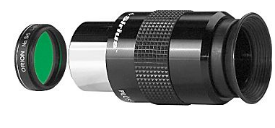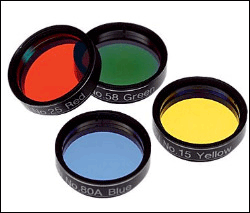

Using Color Filters
Seeing Planets in a Different Light Reveals More Detail
Earth's atmosphere is in constant fluctuation; turbulent air currents blur fine surface detail on solar system objects viewed through a telescope. Faint contrasting areas blend together due to "irradiation" ? a distortion of the boundaries between light and dark surfaces.
When you employ a color filter to zero in on a narrow region of the spectrum, the scattering of interfering wavelengths is enormously reduced. Suddenly, the smeared, pale bands of Jupiter resolve into loops and festoons. Delicate markings appear on Saturn's globe, and the Cassini ring division darkens and solidifies. Mars' polar caps stand out like tiny pearls, and vague lunar rilles acquire greater depth and contrast. Bad "seeing" becomes acceptable; good seeing becomes superb!
Because many planets have a characteristic color (e.g., Mars is reddish), you will dramatically increase detail by reducing the predominant hues, uncovering hidden contrast and surface markings. That's why "the Red Planet" is most effectively enhanced with a green filter.
Below is a guide to using color filters to best view the planets in our solar system.
 Mercury
Mercury
#25 Red will make the planet's disk stand out against a blue sky, permitting daytime or twilight viewing. Mercury is usually best observed just after sunset, when the sky is awash in orange light, so employ #21 Orange with high magnifications to see the planet's phases.
Venus
No matter what telescope aperture you use, Venus's excessive brightness usually causes a very "overexposed," roiling image. With a #47 Violet filter, or stacked #58 Green and #80A Medium Blue filters, you'll reduce the severe twinkling for a better view of the fascinating changing phases.
Mars
#25 Red passes the predominant reflections of surface plains and maria, and #21 Orange is good for reducing the intense glare to enhance detail and mottling. The polar caps stand out with #15 Deep Yellow and #80A Medium Blue; examine the melt lines with #58 Green.
Jupiter
This great planet reveals its cloud bands, loops, festoons, ovals, and Red Spot with #11 Yellow-Green, #80A, #58, and #21. Go from seeing only two bands without a filter to seven or more with a filter! Try stacking filters to reduce heavy glare.
Saturn
Many subtle globular details are improved by #15 Deep Yellow. See the difference in brightness of the extremes of the rings with #25, #11, #58, or #80A. #15 helps sharpen Saturn's image in photographs, improving the resolutions of Cassini's division.
Moon
Reduce the Moon's glare with #80A Medium Blue, and enhance the contrast of lunar rilles and strata with #15 Deep Yellow.
Other Uses
You will improve black-and-white photographs by blocking UV light with #15 Deep Yellow. Refractor chromatic distortion is also reduced by #15, and by #80A. The #82A Pale Blue is great for stacking with other colors, and can adjust film color balance by absorbing excess yellow and red. #58 Green will block street light while passing much of the wavelength of doubly ionized oxygen in emission nebulae. Try #25 Red for long black-and-white exposures of the Omega or Rosette Nebulas.
Do you have questions about selecting the right color filter? Email us at sales-uk@telescope.com, and we'll help you find what you need!






 /
/ 






